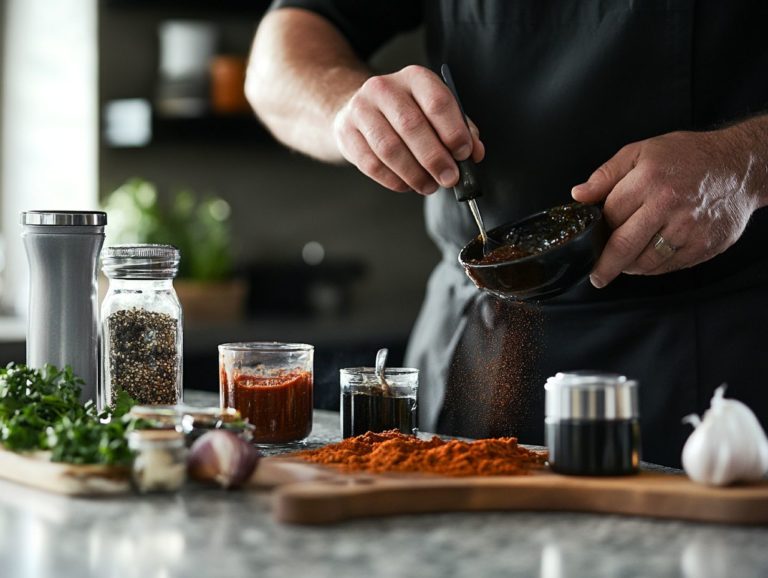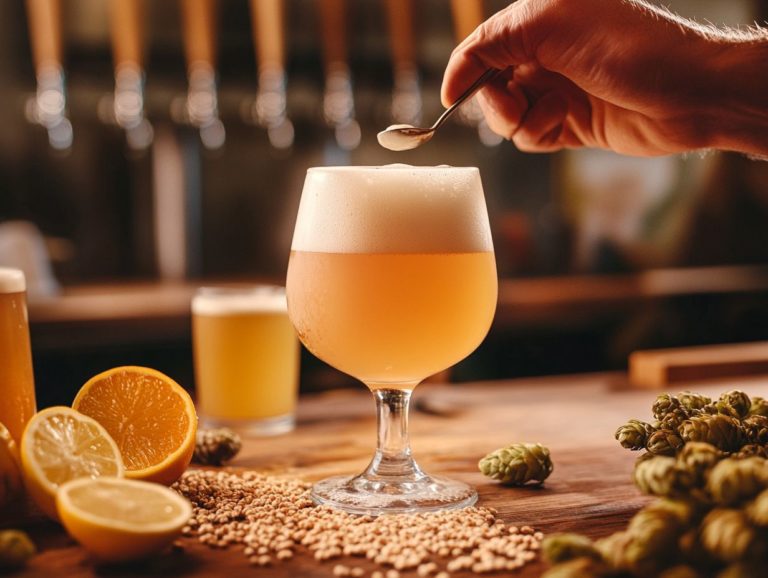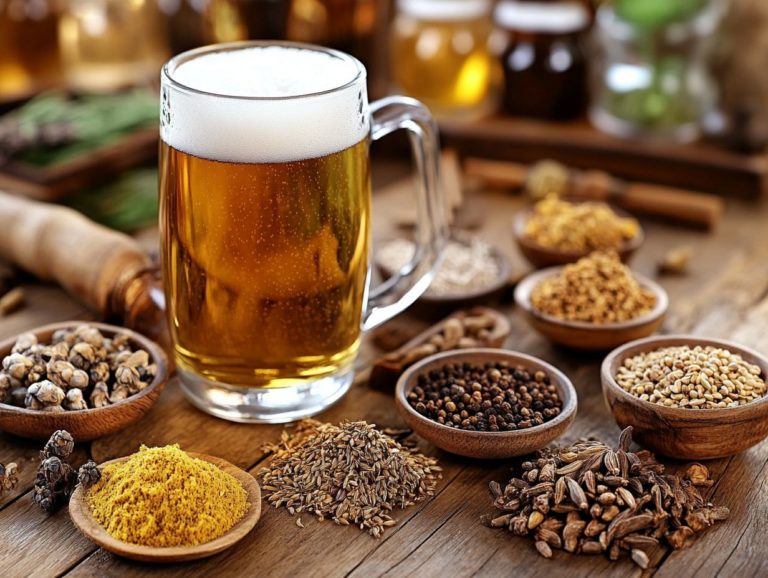How to Fix Oxidation in Your Brew
Oxidation plays a pivotal role in beer brewing, influencing flavor, aroma, and overall quality in remarkable ways. Grasping the causes of oxidation and recognizing how it presents itself in your beer is essential for preserving the integrity of your brew.
This article delves into the sources of oxygen that can lead to oxidation, revealing its unmistakable signs and the effects of oxidation on both the flavor and color of your beer. You’ll find essential tips for preventing oxidation, addressing affected brews, and ensuring that your future batches remain flawless.
Whether you’re a seasoned brewer or just embarking on your brewing journey, this guide empowers you to master oxidation and create outstanding brews!
Contents
- Key Takeaways:
- What is Oxidation in Brewing?
- What Causes Oxidation in Brewing?
- What Are the Signs of Oxidation in Your Brew?
- How Does Oxidation Affect the Flavor of Your Brew?
- How Does Oxidation Affect the Color of Your Brew?
- How to Prevent Oxidation in Brewing?
- How to Fix Oxidation in Your Brew?
- How to Avoid Oxidation in Future Brews?
- Frequently Asked Questions
Key Takeaways:

- Oxidation in brewing can greatly affect the flavor and color of your brew.
- Common sources of oxygen in brewing include improper storage and transfer of ingredients.
- To fix oxidation in your brew, try using methods such as keg purging, transferring to a secondary fermenter, or blending with fresh ingredients.
What is Oxidation in Brewing?
Oxidation in beer brewing is the chemical process that unfolds when your beer comes into contact with oxygen, and it can spell trouble for both quality and stability. This exposure can compromise the taste, twisting flavors and aromas into something less than desirable, potentially delivering bad tastes that no one wants to experience.
Understanding oxidation is essential, especially if you’re a brewer or a dedicated homebrewer aiming to enhance your brewing technique and craft exquisite beers. This knowledge is particularly vital for beer styles that are sensitive to oxidation, such as New England IPAs and barleywines, where the effects can be strikingly pronounced.
What Causes Oxidation in Brewing?
Oxidation in brewing stems chiefly from the unwelcome presence of oxygen at various stages of the brewing process, starting from wort aeration before fermentation and extending to exposure during kegging beer or bottling beer. Oxygen can trigger brewing problems that compromise your beer s quality.
The fermentation process, which hinges on yeast activity and the production of carbon dioxide, is pivotal in determining the residual oxygen levels in the beer and how that oxygen interacts with other ingredients during active fermentation.
What Are the Common Sources of Oxygen in Brewing?
Common sources of oxygen in brewing include wort aeration, which happens when you prepare the wort, as well as during kegging and bottling processes, where contact with air bubbles can introduce unwanted oxygen. Another significant source is the transfer methods you use; for example, open systems tend to increase the likelihood of oxygen exposure compared to closed transfer systems that are designed to minimize this risk.
You need to be mindful of your equipment and methods to better control oxygen levels throughout the brewing process. To mitigate oxygen exposure, consider incorporating shiny tubing, which can significantly enhance the flow of liquids without trapping air. Utilizing oxygen-absorbing bottle caps during the bottling phase provides an extra layer of protection against oxygen permeation.
By adopting these specific techniques and equipment, you can greatly reduce the risk of oxidation, ensuring that the freshness and quality of your beer are preserved from fermentation all the way to the final product. This is particularly crucial for maintaining the frothy head and visual appeal of your homebrew.
What Are the Signs of Oxidation in Your Brew?
Spotting oxidation signs quickly is vital to preserving your beer s flavor and quality! When beers undergo oxidation, they often reveal distinct flavor changes, including that unwelcome cardboard-like off flavor, stale aromas, and a significant decline in hop character especially in beer styles like New England IPAs, which are known for their vibrant profiles.
You might also notice a darkening or haziness in the beer’s color, signaling possible oxidation that could ultimately compromise the overall quality of your cherished creation.
How Does Oxidation Affect the Flavor of Your Brew?

Oxidation has a profound impact on the flavor profile of your brew, often introducing off-flavors that are far from desirable. You might encounter common flavors associated with oxidation, such as cardboard, paper, and sherry-like notes. These can easily mask the flavors you want in your beer, particularly in hoppy styles or those that rely on fresh ingredients, like dry hopping with malted oats.
Oxidized beers also may lack the vibrant flavors of beer that you initially aimed for. This alteration primarily takes place during fermentation when oxygen interacts with specific compounds, transforming vibrant hop aromas into muted, stale characteristics. As your beer matures, these changes can become increasingly pronounced, shifting bright notes into dull or even rancid flavors.
Some brewers use Campden tablets or sodium metabisulfite to reduce oxygen. To combat these undesirable changes, focus on minimizing oxygen exposure throughout the brewing and packaging processes. Techniques such as purging kegs with CO2 and utilizing airtight containers can significantly help maintain the integrity of your beer. Employing proper aeration techniques during the brewing process also plays a key role in maintaining beer quality.
Regularly tasting your product is crucial for identifying any off-flavors early on, allowing you to implement corrective measures before the final release. This can be particularly effective when using homebrew techniques to refine your process.
How Does Oxidation Affect the Color of Your Brew?
The impact of oxidation on the color of your brew is just as crucial as its influence on flavor, often leading to beers that are darker or hazy than you intended. This color shift occurs due to the chemical reactions between oxygen and the various compounds in the malt and hops, which not only alters the appearance but also affects how fresh the beer seems.
Bryan Roth, a well-known beer writer from Durham, North Carolina and the author of “This Is Why I m Drunk,” has often highlighted the importance of visual appeal in beer quality. A visually stunning beer invites curiosity, prompting customers to explore the flavors within.
For example, you might find that pale ales take on an unexpected dullness, while richer beers like imperial stouts could develop an unsightly murkiness. Such changes can significantly diminish the visual appeal, potentially turning away customers before they even take a sip. Maintaining beer stability is thus crucial for marketability.
Consumer perception is vital in the world of craft beer, where those first impressions can greatly impact overall satisfaction. To avoid these unwelcome transformations, you can adopt strategies like minimizing oxygen exposure during packaging and storage, employing nitrogen flushing, or opting for more robust hop varieties. Utilizing Br u Supply’s advanced brewing equipment can also help in maintaining the desired beer flavors.
By preserving the desired color integrity, you can maintain the visual aesthetics that not only captivate the senses but also enhance the marketability of your products. Employing Kveik yeast known for its robust fermentation properties can help maintain the visual and taste consistency of your beers.
How to Prevent Oxidation in Brewing?
Preventing oxidation in brewing is essential for preserving the quality and stability of your beer. To achieve this, you must implement effective aeration techniques during the brewing process and minimize oxygen exposure throughout fermentation, kegging, and bottling. Proper racking beer techniques also play a significant role in avoiding oxidation.
Utilizing closed transfer systems, purging kegs with carbon dioxide, and maintaining yeast health are critical practices that significantly reduce the risks associated with oxidation. By prioritizing these methods, you can ensure that your beer retains its intended flavors and aromas, delivering an exceptional experience with every sip. Act now to preserve the incredible quality of your beer! Implement these techniques today to ensure every sip is exceptional.
Employing a reliable fermentation vessel also ensures that oxidation is kept at bay.
What Are the Best Practices for Reducing Oxygen Exposure in Brewing?
Implementing best practices for reducing oxygen exposure is essential for any brewer who aspires to craft exceptional beers. Key strategies include:
- utilizing oxygen-absorbing bottle caps,
- ensuring closed transfer methods during the racking process,
- and maintaining a consistent storage temperature to minimize oxidation risks during beer conditioning.
Selecting the right fermenters with airtight seals can significantly enhance your ability to control oxygen levels throughout the primary fermentation stage. When bottling, consider using a counter-pressure filler; this sophisticated tool helps preserve freshness by minimizing the amount of air introduced into each bottle. Investing in efficient brewing equipment also plays a vital role in maintaining beer quality.
It s equally important to meticulously purge kegs with CO2 before filling them, effectively displacing any lingering oxygen. For those serious about their craft, integrating oxygen measurement equipment to accurately monitor levels during the brewing process is a game changer. Using an auto-siphon during the transfer process can also minimize oxygen exposure.
By adopting these techniques and employing specialized equipment designed to minimize oxygen impact, you can enhance beer stability and elevate the overall enjoyment of your brew.
How to Properly Store Your Ingredients to Avoid Oxidation?
Proper ingredient storage is absolutely essential for you to avoid oxidation and maintain the integrity of your homebrew supplies. Ingredients like hops, malt, and yeast should be kept in airtight containers in a cool, dark environment, minimizing their exposure to oxygen to ensure they stay fresh and potent. Storing your yeast in a beer fermenter with an airtight seal can greatly improve the longevity and quality of your ingredients.
By paying close attention to temperature control, you can significantly enhance the quality of your beers. Hops, for instance, should ideally be stored in the freezer to lock in their aromatic oils, while malted oats can be kept at cooler room temperatures, away from light. Investing in vacuum-sealed bags or tightly sealed plastic containers will further safeguard these vital ingredients. Ensuring proper storage temperature also maintains the flavors of beer you work hard to achieve.
Make it a habit to regularly check for signs of spoilage, such as off smells or discoloration, so you can catch any potential issues before they affect your final product. By implementing these thoughtful storage practices, you ll be on your way to consistently brewing high-quality beer that impresses with every sip. Whether you’re new to homebrew or an experienced brewer, mastering these techniques is essential.
How to Fix Oxidation in Your Brew?

Addressing oxidation in your brew can be quite the challenge, yet there are several effective methods you can employ to salvage an oxidized batch. Understanding the beer brewing process and recognizing the effects of oxidation are crucial in this endeavor.
Consider techniques like:
- blending with fresher beer
- fine-tuning the beer conditioning process
- utilizing Campden tablets to neutralize off flavors
- racking beer carefully to avoid oxygen exposure
While these approaches can help restore some balance to your oxidized beers, it’s important to acknowledge that complete recovery may not always be achievable.
What Are the Different Methods for Removing Oxygen from Your Brew?
You have a variety of effective methods at your disposal for removing oxygen from your brew. Utilizing these techniques can significantly elevate the quality of your final product.
One powerful method is keg purging with carbon dioxide, which effectively displaces oxygen within the keg. Employing closed transfer systems during the racking process minimizes oxygen exposure. Additionally, Campden tablets can help mitigate the effects of any residual oxidation. Proper wort aeration during the active fermentation phase is also critical to reduce oxygen exposure.
Using the right handling techniques throughout the brewing process is essential. For instance, keeping fermentation vessels sealed until it’s necessary to transfer can greatly limit oxygen contact. If you’re a homebrewer, consider using oxygen-scavenging caps on your bottles, and ensure that all your equipment is thoroughly sanitized and purged before use. Utilizing shiny tubing for transferring can further limit oxygen exposure, creating an optimal brewing environment.
In commercial settings, large-scale brewers often invest in nitrogen flushing, which efficiently pushes out oxygen from storage tanks, ultimately extending the shelf life of their beers. Proper temperature control is also critical in these settings. Adopting these practices ensures brewers can protect and enhance the quality of every batch, resulting in tastier and more stable products.
Can You Salvage an Oxidized Brew?
Salvaging an oxidized brew may seem daunting, but several techniques can help you restore your beer’s quality. The right approach depends on how far gone the oxidation is, but methods such as blending with fresh beer, using adjuncts additional ingredients used in brewing to enhance flavor to mask any off flavors, or incorporating specific brewing techniques can significantly enhance the overall taste.
For instance, blending a batch of oxidized ale with a lighter, fresher brew can create a balanced flavor profile, effectively softening the harsh effects of oxidation. Try adding fruits or spices as adjuncts to revive stale flavors and create an exciting new twist! Understanding the chemical process of oxidation can also guide you in choosing the right adjuncts.
Moreover, case studies show that a careful layering of hop aromas through late additions can effectively mask mustiness and restore the vibrancy that may have been lost. By embracing these techniques, which can include the use of New England IPA methods with malted oats, you not only elevate the quality of your salvaged brew but also embody the innovative spirit that lies at the heart of homebrewing.
How to Adjust the Flavor of an Oxidized Brew?
Adjusting the flavor of an oxidized brew requires you to strategically correct the off flavors that have emerged from the oxidation process. Techniques such as blending in fresh beer, using sugar to enhance sweetness, or adding additional hops during the dry hopping phase can effectively rebalance the flavors and mask those undesirable characteristics. The use of barleywine methods can also offer a robust solution.
Consider exploring the addition of fruit purees or citrus zest; these can introduce refreshing notes that elevate the overall profile of your brew. Ingredients like coffee or chocolate can bring depth and complexity, successfully overshadowing any stale flavors that oxidation might have introduced. Yeast health is also crucial in ensuring these flavors integrate well.
Don’t shy away from experimenting with spices such as cinnamon or vanilla, as they can impart a warm and inviting aroma that distracts from any unwanted traits. Utilizing the right brewing equipment can also help achieve these results. By employing these methods, you not only recover the integrity of your brew but also craft a unique flavor experience that truly delights the palate.
Try out these methods and share your experiences!
How to Avoid Oxidation in Future Brews?
To prevent oxidation in your future brews, take a proactive stance by employing effective homebrewing techniques. Maintain optimal conditions throughout the brewing process to ensure success.
Consult resources like Br u Supply or writings by Bryan Roth for valuable insights. Key practices to focus on include:
- Ensuring proper aeration during the fermentation process,
- Minimizing oxygen exposure during the kegging and bottling stages,
- Controlling the storage temperature for both your ingredients and finished beer; consistent temperature control is critical.
By following these steps, you can significantly enhance the overall quality and stability of your beer.
Frequently Asked Questions

How can I tell if my brew has been oxidized?
Several signs indicate that your brew has been oxidized. Look for a stale or “cardboard” taste, loss of head retention, and a darker color than expected. You might also notice a lack of aroma or a vinegar-like smell.
Monitoring the frothy head can be an early indicator of oxidation.
What causes oxidation in brew?
Oxidation occurs due to exposure to oxygen. This can happen during the brewing process, such as when transferring the brew from one container to another, or during bottling. It can also occur after bottling if the bottles are not properly sealed or stored.
Using appropriate fermentation vessels can help minimize this risk.
How can I prevent oxidation in my brew?
The best way to prevent oxidation is to limit exposure to oxygen. Minimize splashing during transfer, use a siphon to move the brew, and ensure bottles are properly sealed and stored.
Consider adding antioxidants, such as Vitamin C or sodium metabisulfite, to keep your brew fresh and delicious!
Utilizing an auto-siphon, a device that helps transfer liquids with minimal oxygen exposure, can make the process more efficient.
Can I fix oxidation in my already brewed beer?
While it is difficult to completely reverse oxidation, you can improve the taste. Try adding a small amount of fresh, unoxidized beer to dilute off-flavors.
Additionally, adding some yeast or sugar to the bottles can create carbonation and mask stale taste. Incorporating Kveik yeast may sometimes enhance the final result.
How long does it take for oxidation to occur in brew?
Oxidation can happen at any point during brewing or after bottling. However, it is more likely to occur after bottling and can continue to progress over time.
The rate of oxidation also depends on the type of brew and storage conditions. For instance, imperial stout and other beer styles can be more prone to oxidation if not properly managed.
Are there any benefits to controlled oxidation in certain styles of brew?
In some beer styles, such as certain Belgian ales, controlled oxidation can be beneficial. It helps to create a complex and desirable flavor profile.
However, for most styles of beer, oxidation is considered a flaw and should be avoided. Understanding this can help you avoid oxidation in your brews.






